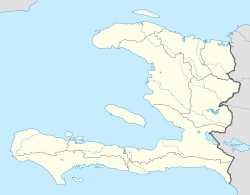Ouanaminthe
|
Ouanaminthe Wanament / Wanamèt |
||
|---|---|---|
| Commune | ||
|
||
| Location in Haiti | ||
| Coordinates: 19°33′0″N 71°44′0″W / 19.55000°N 71.73333°WCoordinates: 19°33′0″N 71°44′0″W / 19.55000°N 71.73333°W | ||
| Country |
|
|
| Department | Nord-Est | |
| Arrondissement | Ouanaminthe | |
Ouanaminthe (Haitian Creole: Wanament or Wanamèt; Spanish: Juana Méndez) is a commune or town located in the Nord-Est Department of Haiti. It lies along the Massacre River, which forms part of the natural border between Haiti and the Dominican Republic. Ouanaminthe is the largest commune in northeastern Haiti. The bridge connecting Ouanaminthe to the Dominican city of Dajabón is one of the four main border crossings between the two countries. Throughout its history, the city has repeatedly been a site of conflict in international disputes, first between French and Spanish colonists, and in more modern times as part of the long-standing Haitian-Dominican conflict.
The population stands at roughly 100,000 people, including the immediate vicinity. Haitians living in Ouanaminthe are allowed to cross the border freely without documents two days per week, mainly for the market on Mondays and Fridays at Dajabón, where they buy and sell goods. In 2010, a new bridge and the new market store, funded by the European Union, was opened.
The name Ouanaminthe is the French form of the Taíno word Guanaminto, which was the reported pronunciation of the name of the indigenous village that preexisted European settlement on the present-day town site.
The Haitian Creole form, Wanament, is simply the Creolization of the French name.
The Spanish form, Juana Méndez, comes from the name of the Haitian ex-slave Juana Méndez, the mother of Buenaventura Báez Méndez, the first mulatto President of the Dominican Republic.
...
Wikipedia


